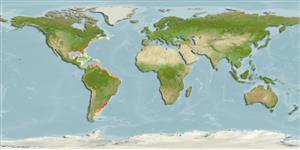Environment: milieu / climate zone / Tiefenbereich / distribution range
Ökologie
seewasser; brackwasser demersal; ozeanodrom (Ref. 51243); tiefenbereich 10 - ? m. Subtropical; 46°N - 51°S
Western Atlantic: Nova Scotia (Ref. 7251) to Florida, Gulf of Mexico, the Antilles (uncommon), and the southern Caribbean coast; also from the Orinoco delta to Argentina.
Length at first maturity / Size / Gewicht / Alter
Geschlechtsreife: Lm 64.5, range 63 - ? cm
Max length : 170 cm TL Männchen/unbestimmt; (Ref. 7251); common length : 50.0 cm TL Männchen/unbestimmt; (Ref. 3702); max. veröff. Gewicht: 51.3 kg (Ref. 4699); max. veröff. Alter: 43 Jahre (Ref. 7188)
Rückenflossenstacheln (insgesamt) : 11; Rückenflossenweichstrahlen (insgesamt) : 19 - 22; Afterflossenstacheln: 2; Afterflossenweichstrahlen: 5 - 7. Silvery grey to very dark, young with 4 or 5 black vertical bars on sides, disappearing with growth; pelvic and anal fins usually dark. Chin with 5 pores and 10 to 13 pairs of small barbels along median edges of lower jaws and subopercles, increasing in length posteriorly. Gas bladder with numerous lateral appendages interconnected in a complicated pattern in adult. Sagitta semicircular and moderately thin (Ref 51721).
Body shape (shape guide): fusiform / normal.
Found usually over sand and sandy mud bottoms in coastal waters, especially in areas with large river runoffs. Juveniles often enter estuaries. Feeds mainly on crustaceans, mollusks and fishes.
Robins, C.R. and G.C. Ray, 1986. A field guide to Atlantic coast fishes of North America. Houghton Mifflin Company, Boston, U.S.A. 354 p. (Ref. 7251)
IUCN Rote Liste Status (Ref. 130435: Version 2025-1)
Bedrohung für Menschen
Harmless
Nutzung durch Menschen
Fischereien: kommerziell; Sportfisch: ja; Aquarium: Öffentliche Aquarien
Tools
Zusatzinformationen
Download XML
Internet Quellen
Estimates based on models
Preferred temperature (Ref.
123201): 10.8 - 27.6, mean 23.5 °C (based on 326 cells).
Phylogenetic diversity index (Ref.
82804): PD
50 = 1.0000 [Uniqueness, from 0.5 = low to 2.0 = high].
Bayesian length-weight: a=0.00832 (0.00757 - 0.00914), b=3.08 (3.06 - 3.10), in cm total length, based on LWR estimates for this species (Ref.
93245).
Trophic level (Ref.
69278): 3.4 ±0.5 se; based on diet studies.
Widerstandsfähigkeit (Ref.
120179): mittel, Verdopplung der Population dauert 1,4 - 4,4 Jahre. (K=0.17; tm=3-5; tmax=43).
Fishing Vulnerability (Ref.
59153): High vulnerability (60 of 100).
🛈
Climate Vulnerability (Ref.
125649): Moderate to high vulnerability (54 of 100).
🛈
Nutrients (Ref.
124155): Calcium = 38.1 [22.4, 72.3] mg/100g; Iron = 0.803 [0.422, 1.361] mg/100g; Protein = 19.7 [18.0, 21.7] %; Omega3 = 0.289 [0.175, 0.459] g/100g; Selenium = 37.5 [20.9, 71.1] μg/100g; VitaminA = 4.98 [1.88, 15.13] μg/100g; Zinc = 0.611 [0.443, 0.888] mg/100g (wet weight); based on
nutrient studies.
